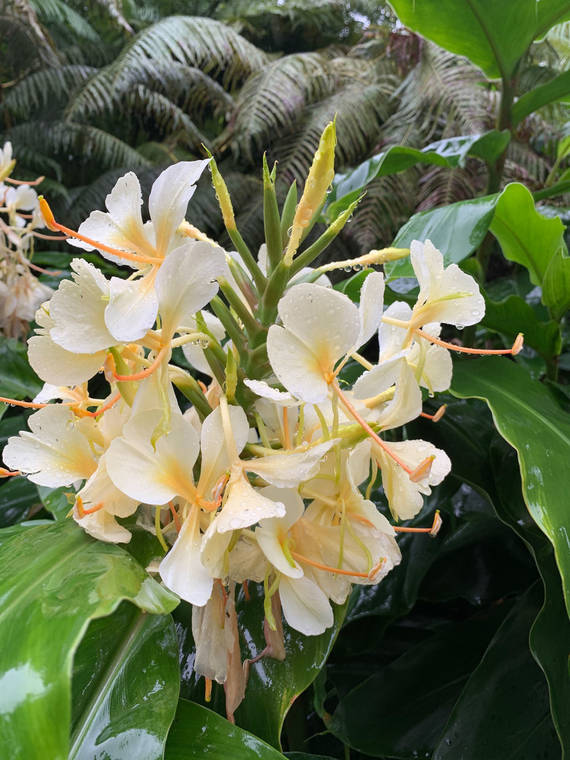Visitors to our islands frequently comment about how fragrant our air smells with the abundance of flowers in bloom.
When we are in good health, we sometimes don’t appreciate it until we get sick. The same holds true when it comes to our amazing gardens. Hawaii is blessed with a vast array of flowers, and we use them in the landscape for many reasons.
Colorful flowering plants add visual beauty. But an added advantage is that many are fragrant.
Moist, humid tropical climates have the potential for volcanic eruptions, rot and decay. This means bad smells, so by adding colorful and fragrant plants to the landscape, we can actually help mask unwanted odors. Gingers are among the easiest plants to grow for this purpose.
Many species have naturalized and we tend to think of them as weeds, but we should be considering that such plants give us beauty and have valuable uses. Pharmaceutical companies have studied the ginger family in recent years and found that many have medicinal qualities. Even the often maligned Kahili ginger has been found to have anti-cancer properties and was used by earlier cultures for a variety of ailments. Edible ginger, or Zingiber officinale; turmeric, or olena; and cardamom are spices but were originally used as medicines and have anti-oxidant properties. The ginger used in Thai cooking is galanga and we must not forget the awapuhi kuahiwi, or soap ginger, that early Polynesians brought to Hawaii many centuries ago.
The ginger family is noted for its many colorful and fragrant species. Gingers are related to the banana, palm and bamboo families, in that they are monocots. Many come from Malaysia, Indonesia and other parts of Southeast Asia.
There are about 50 genera and more than 1,300 species in the family, the majority of which are native to tropical regions of the eastern hemisphere. More are being discovered every year. Most genera are well adapted to Hawaii’s varied climates. Many grow in the tropical zone, but some will thrive at 6,000 or more feet of elevation.
Gingers are rhizomatous perennials, generally with simple unbranched above ground stems. Flowers vary considerably, from small to very showy, and are usually borne in heads. Many of the ginger flowers are so fragrant in some cases that they are overpowering in a small room.
Gingers are relatively easy to cultivate, and once established require little care. They grow well on a wide range of soil types, as long as the soil is moist at all times. Riverbanks and land adjacent to ponds or boggy spots are choice locations and will support the best growth. If gingers are planted on high dry soils, frequent applications of water are necessary.
Handle gingers the same as bananas. They do best in moist soil high in organic matter. An application of fertilizer in early spring when growth begins and two more applications at the same rate during the growing season will be sufficient. The fertilizer applications should be spaced eight weeks apart. Also, compost and well rotted manures applied every three months will help keep the soil sufficiently rich.
Planting or transplanting can be done at any season. The parent clump mcan be divided like any rhizomatous herb. The fleshy underground rhizome can be severed at any point, as long as each piece has at least one good eye to produce a new plant.
Here are some other gingers to consider for your garden. The torch ginger, shell ginger, white ginger, yellow ginger, red ginger and Tahitian red ginger are just a few you will find at local nurseries.
We tend to take gingers for granted in Hawaii, where they grow so easily, but few plant materials give so much for so little work. Try several types if you have the room in your garden.
Be cautious planting Kahili ginger. It can seed readily under the right conditions. Rhizomes of this ginger can be tenacious and difficult to remove once established. On the other hand, it is well suited to steep hill sides for reducing soil erosion.






